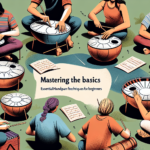The Therapeutic Power of Handpan Meditative Music
The handpan, a relatively modern instrument, has garnered attention for its ethereal sound and unique design. It was created in the early 21st century, drawing inspiration from the steel drum. The handpan typically consists of two metal shells glued together, creating a resonant body that produces rich, harmonious tones when played. This instrument is now considered a powerful tool for meditation and therapy, due to its soothing musical qualities.
The Birth of the Handpan
The handpan’s origins are traced back to Switzerland, where creators Felix Rohner and Sabina Schärer, founders of PANArt, introduced the Hang drum in 2000. This new instrument combined elements of the steel drum with aspects of traditional instruments such as the tabla and gamelan. The Hang, an earlier form of the handpan, quickly captivated audiences worldwide with its hauntingly beautiful sound. The handpan, as it evolved from the Hang, retained these characteristics while incorporating new design features that enhanced its versatility and accessibility.
Sound and Healing
Sound therapy has been practiced for centuries across different cultures, with instruments like Tibetan singing bowls, gongs, and tuning forks used to induce states of relaxation and healing. The handpan fits seamlessly into this tradition, with its resonant tones and harmonious vibrations promoting physical, mental, and emotional well-being.
When played, the handpan produces a mesmerizing, cyclical sound that can entrain the brain into specific frequencies associated with states of deep relaxation and meditation. This phenomenon, known as brainwave entrainment, involves synchronizing the brain’s natural rhythms with an external stimulus, effectively guiding the listener into a meditative state. Studies have shown that these states can reduce stress, lower blood pressure, and boost immune function, among other health benefits.
Cognitive and Emotional Benefits
Handpan meditative music not only affects physical health but also offers significant cognitive and emotional benefits. For individuals dealing with anxiety, depression, or other mental health issues, the calming effect of handpan music can provide a much-needed respite. It creates an auditory environment that can help quiet the mind, allowing listeners to detach from negative thought patterns and experience a sense of peace and tranquility.
Additionally, the handpan’s soundscape encourages mindfulness, a practice of staying present and fully engaged with the current moment. Mindfulness has been shown to improve concentration, memory, and emotional regulation. By providing a focus for meditation, handpan music facilitates mindfulness practices, making it easier for individuals to incorporate these into their daily routines and reap the associated cognitive benefits over time.
Group Meditation and Community Building
Handpan meditative music is not confined to solo experiences; it also plays a pivotal role in communal healing and meditation sessions. Group meditation, supported by the harmonious tones of the handpan, can foster a sense of unity and shared experience where participants may feel more connected with each other and the collective energy of the group. This can amplify the emotional and psychological benefits of meditation, offering a heightened sense of belonging and support.
Furthermore, the handpan community itself is often described as welcoming and inclusive, with musicians and enthusiasts regularly gathering for jams, workshops, and festivals. These events provide opportunities to learn, share, and collaborate, strengthening the bonds between individuals who share a passion for this unique instrument. The handpan thus becomes a catalyst for social interaction and personal growth, creating a positive feedback loop that enhances the well-being of its players and listeners alike.
Integration into Yoga and Mindfulness Practices
Yoga practitioners and mindfulness instructors have increasingly integrated handpan music into their sessions. The instrument’s soothing sounds align perfectly with the slow, deliberate movements and meditative states encouraged in these practices. The rhythmic, melodic nature of the handpan can guide breathwork, assist in maintaining focus during poses, and deepen the sense of relaxation during savasana (the final resting pose in yoga).
Moreover, the handpan’s versatility allows it to complement various styles of meditation, from guided visualizations to silent retreats. Its ability to evoke a sense of calm and serenity makes it an ideal backdrop for practices aimed at self-awareness, inner peace, and emotional healing.
Learning and Playing the Handpan
Engaging with the handpan isn’t limited to listening; playing the instrument can be a deeply therapeutic experience in itself. Many beginners find that the layout of the handpan, with its intuitive arrangement of notes, allows for quick learning and immediate gratification. The act of creating music with the handpan can be meditative, helping players enter a flow state where time seems to stand still.
This active form of meditation can reduce stress and anxiety, providing a sense of achievement and creative expression. Whether playing alone or with others, the handpan offers a unique avenue for emotional release and personal transformation.
Conclusion
Handpan meditative music offers a transformative experience that resonates deeply on multiple levels—physically, mentally, and emotionally. Its soothing soundscapes can ease stress and anxiety, promote mindfulness, and foster a sense of community and connection. Whether listening to the entrancing tones or creating music oneself, the handpan provides a powerful tool for personal growth and therapeutic healing. As this instrument continues to inspire and unite individuals worldwide, its role in holistic well-being becomes ever more apparent.
FAQs
1. What is a handpan?
A handpan is a steel percussion instrument developed in the early 21st century. It consists of two metal shells glued together, creating a resonant body that produces harmonious tones when played.
2. How does handpan music benefit mental health?
Handpan music can reduce stress and anxiety, promote relaxation, and facilitate mindfulness practices. Its soothing tones have been shown to help quiet the mind and induce meditative states, offering significant cognitive and emotional benefits.
3. Can anyone learn to play the handpan?
Yes, the handpan is known for its intuitive design, which makes it accessible to beginners. Many find that they can create pleasing music with the handpan relatively quickly, making it an enjoyable instrument for players of all skill levels.
4. How is the handpan used in group meditation?
In group meditation sessions, handpan music can provide a unifying auditory experience that helps participants feel more connected. Its soothing sounds enhance the meditative atmosphere, supporting a collective sense of peace and relaxation.
5. Where can I experience handpan meditative music?
You can experience handpan meditative music at concerts, festivals, yoga sessions, and mindfulness workshops. You can also find recordings online or invest in a handpan to explore its therapeutic effects firsthand.





